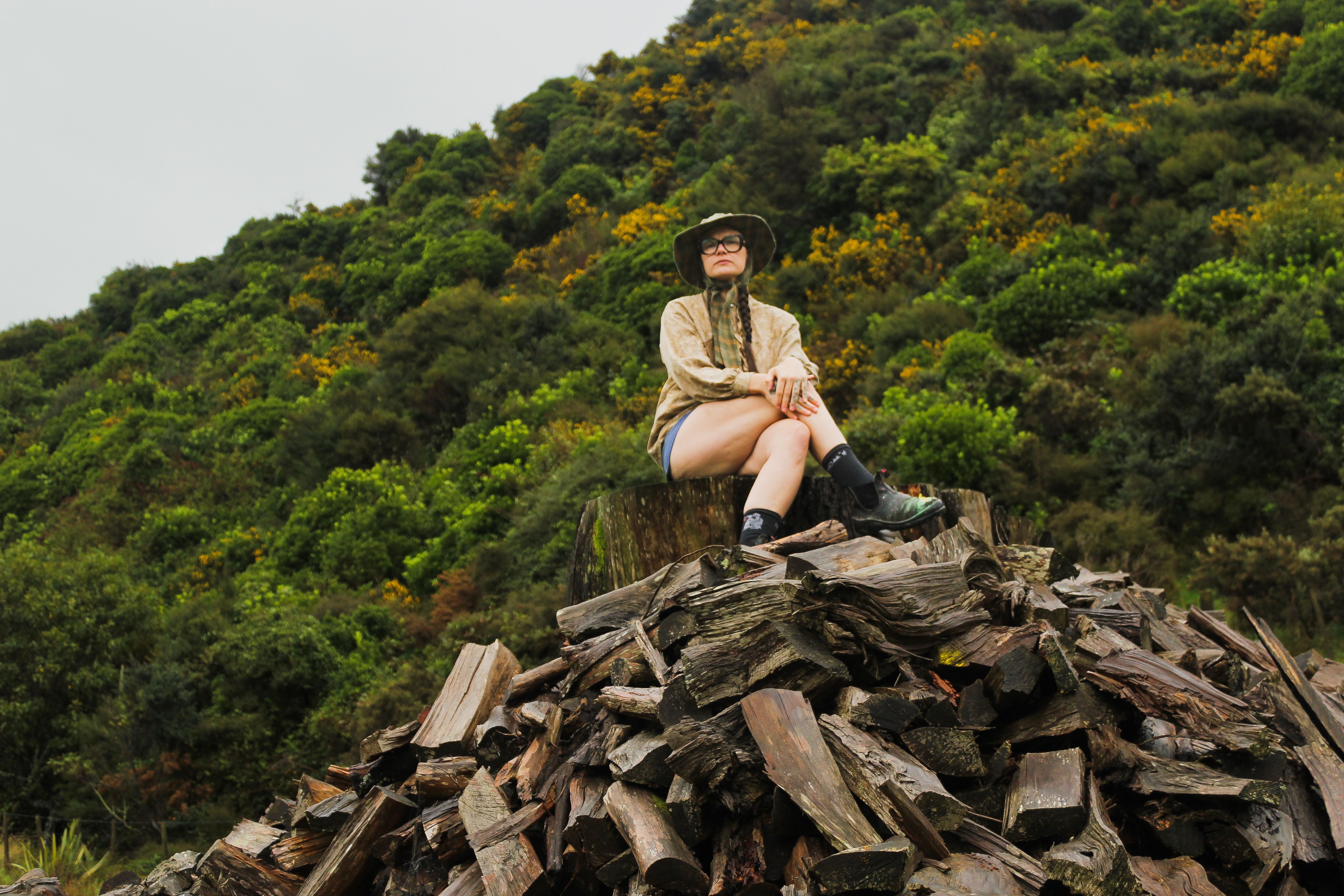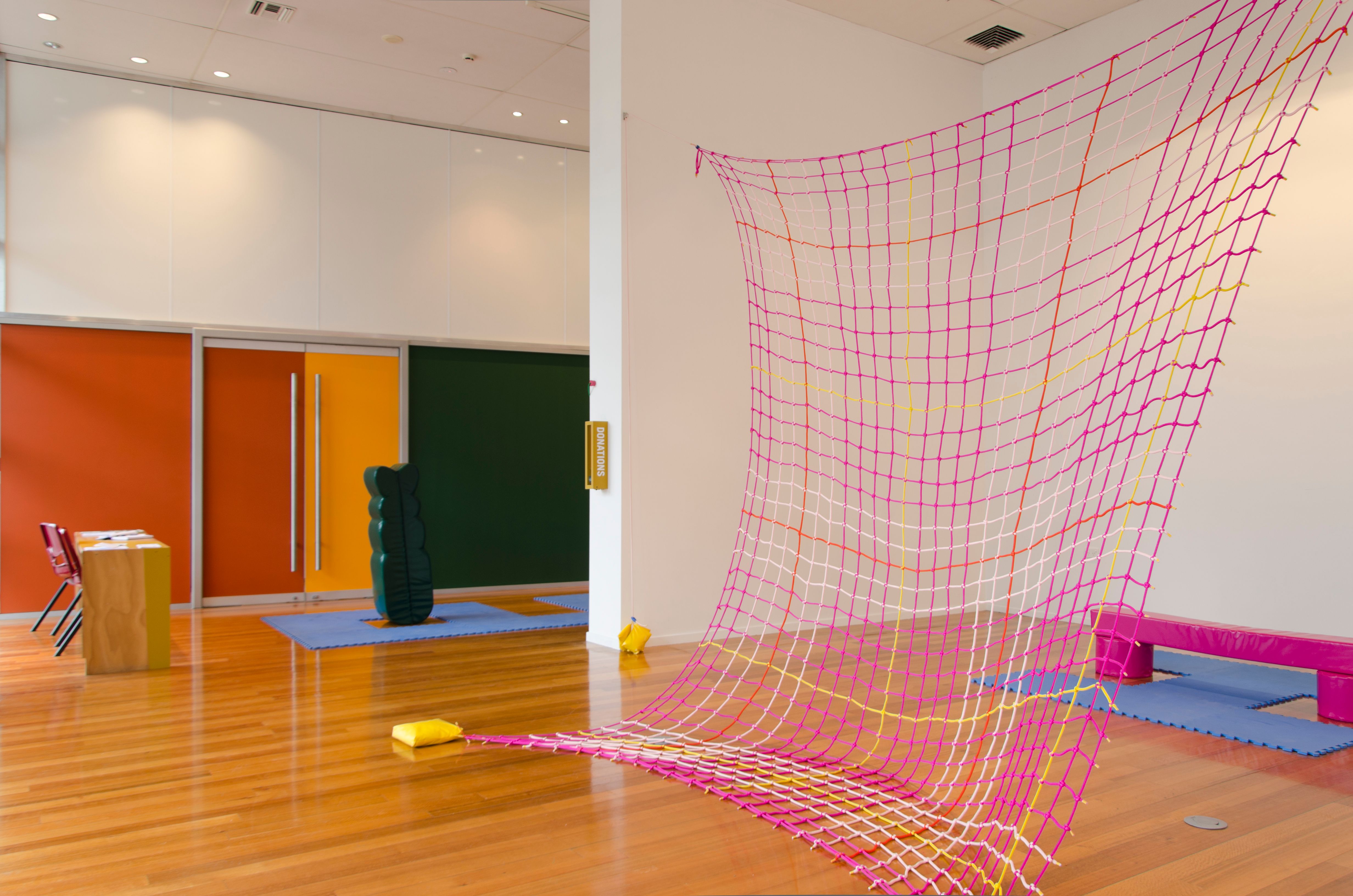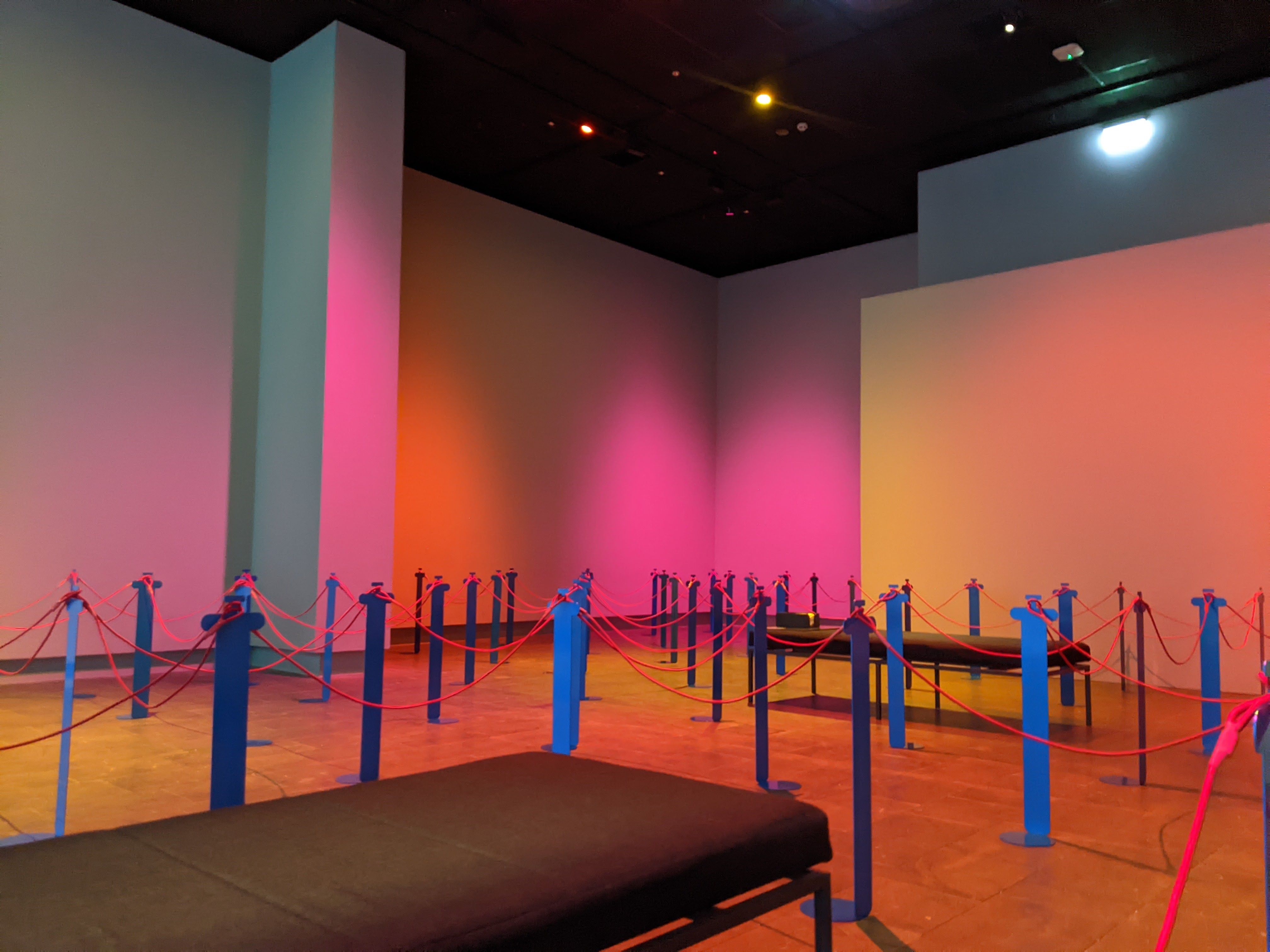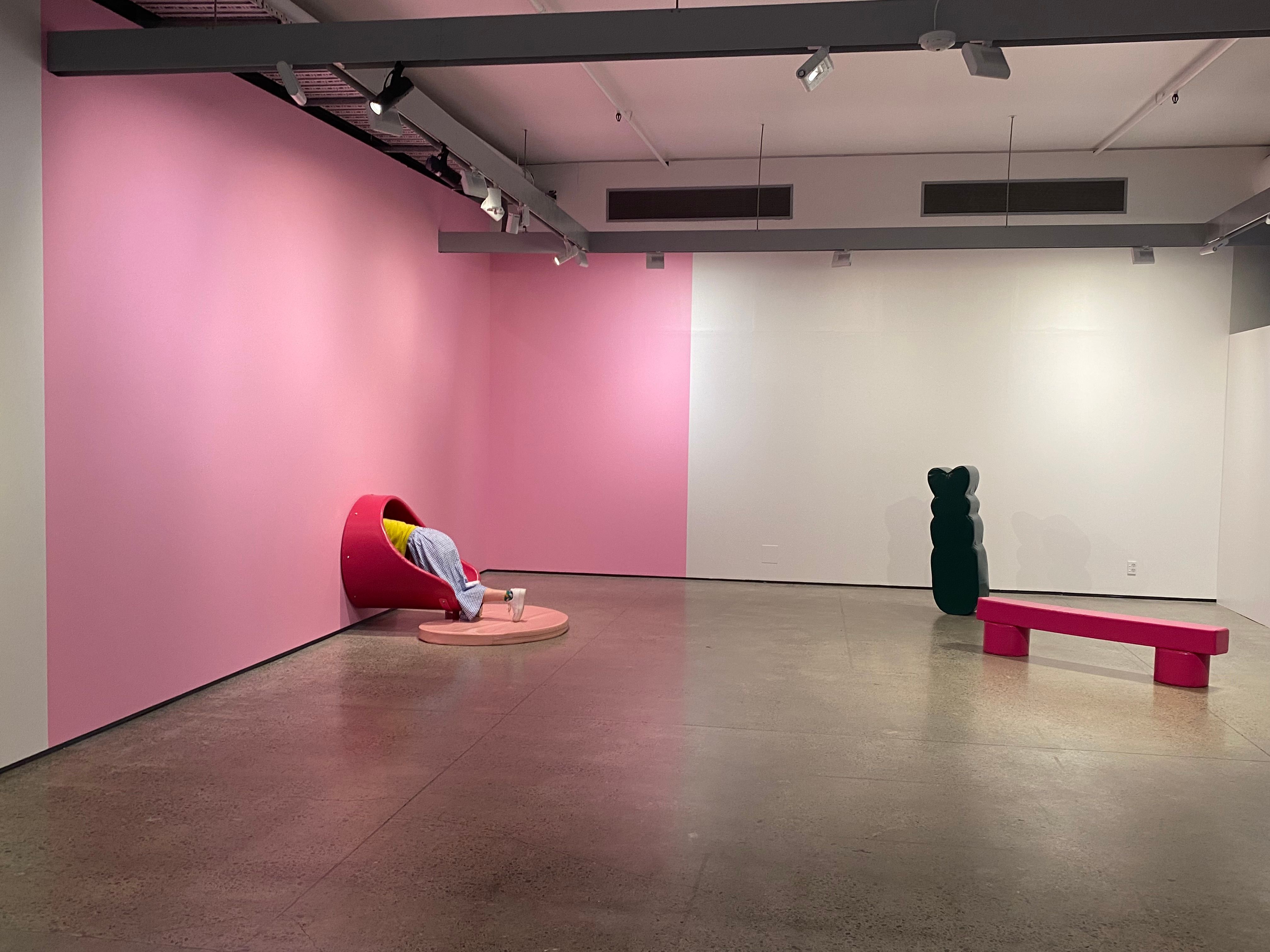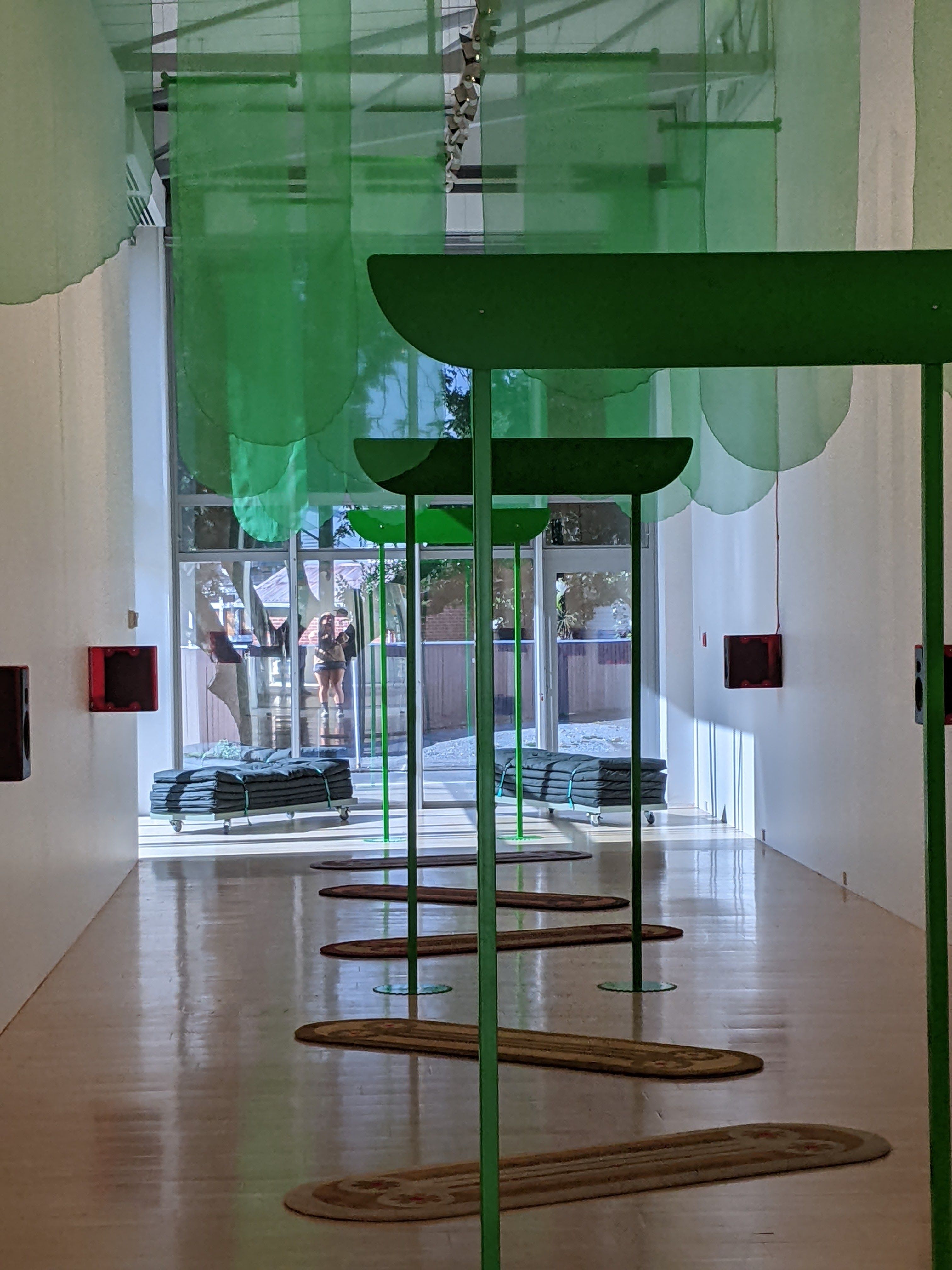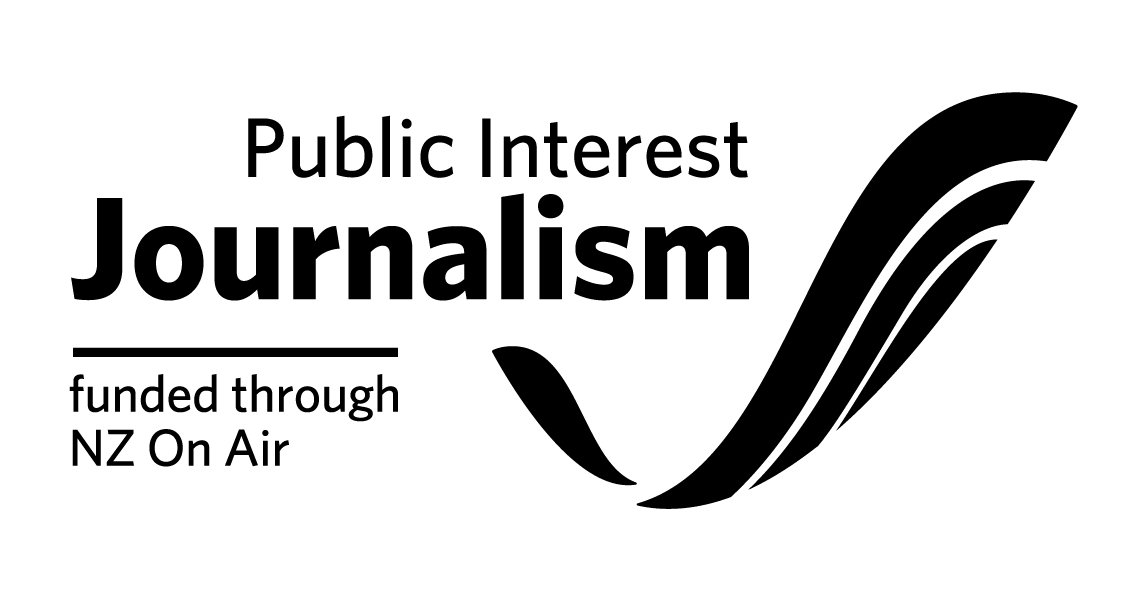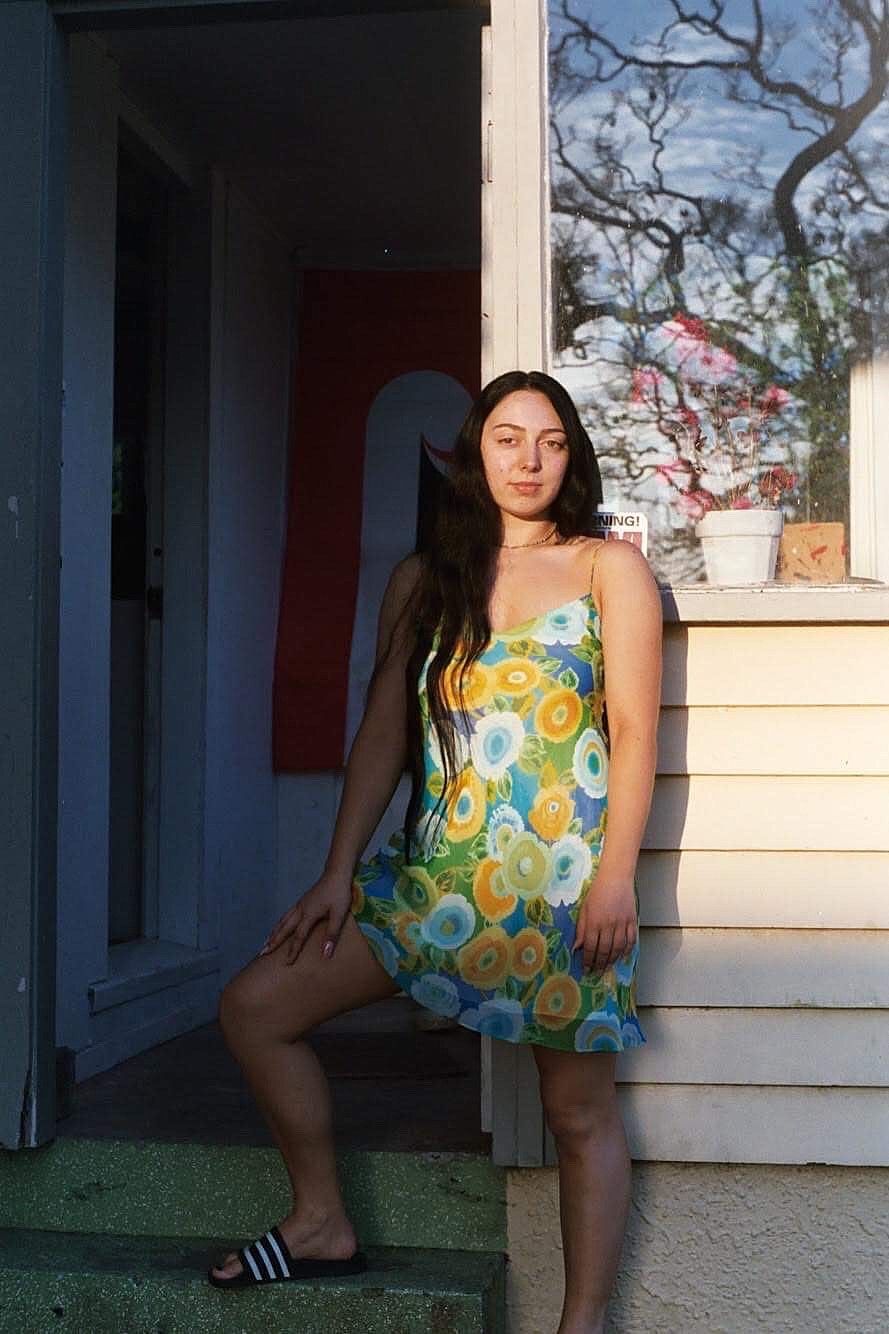Living and Ripening: Turumeke Harrington
Turumeke Harrington is a refreshing force in Aotearoa and Te Waipounamu. This Kāi Tahu artist makes the type of big-picture, approachable art that plays in the background of people’s minds as they are falling asleep, dreaming big. Mya Morrison-Middleton sits down to interview Turumeke about her career so far.
Turumeke Harrington’s work is unparalleled across art and design. She has an intuitive cleverness with materials and space, and in opening conversations that flow over pūrākau, motherhood, ancestors, existential doom, the housing crisis and relating well with others. Many of her influences come from within her whakapapa, such as her namesake Ema Turumeke, the writings of Kāi Tahu leader Matiaha Tiramōrehu, and her whānau. I wouldn’t label her work as earnest, but it reaches into the future and the past with kindness and humour.
Turumeke is in her sunny new studio while we talk. Our call starts off choppy, we blame it on the wifi at her country home. She recently moved to the outskirts of Te Whanganui-a-Tara with her partner James and daughter Pia. To begin, I ask about her early life. It’s awkward pretending we don’t know each other – there’s lots of laughing.
“Art is anything that you want it to be, it’s the most made-up thing in the whole world.”
Turumeke grew up in Ōtautahi Christchurch, then Rotorua, before moving to Te Whanganui-a-Tara to study industrial design. After this she moved to Melbourne. “I studied shoemaking then I retired from shoemaking. Then I moved to Lyttleton and had a baby… At some point in there I got divorced. That’s always fun. Do you want to include that little spicy detail?” I do. It’s hard to describe Turumeke’s manner in words, but she is direct, full of banter and seriously welcoming.
“I didn’t even think I would be an artist,” Turumeke insists, because of the way art had been presented as a “personal church or something we all release in. I still don’t find great catharsis in making.” After a brief stint in Canada, she returned home to Te Waipounamu, where she was offered a scholarship to study fine arts at Canterbury University. There she discovered that “art is anything that you want it to be, it’s the most made-up thing in the whole world.” For Turumeke art is a way of “processing and understanding things around you.”
Hey māma come play with me, 2019. Installation view. Image credit: The Physics Room / Mitchell Bright.
Turumeke considers her first actual exhibition the 2019 solo show Hey māmā come play with me at The Physics Room, an energetic art playground of star-knotted nets, lights and PVC props. It’s been four years since then – “Not very long ago really. Is it? Fuck.” Since then she has had a busy schedule of solo exhibitions across the country and has gained a reputation as a jack of all trades; she makes huge interactive site-specific installations, jewellery, furniture, paintings and really comfy socks.
To explain her cross-pollinated approach to making across mediums, she refers to her training as an industrial designer, a career she says she didn’t have the patience for. “I don’t have the temperament to be a professional industrial designer… you have to respond to a specific client, or a specific market. My patience and temperament are better suited to making artworks and things I want to make. Because otherwise I get bored.” Her merging of art and design is a practical desire path. “The crossovers between art and design and craft are not driven by any great political statement,” she says. “These are the skills that I have, so I use them."
Turumeke makes the kind of art that gives caregivers a sigh of relief when they bring kids to the gallery. It’s tactile. People can actually sit on the art, and everything is the colour of a lolly. This is intentional. “I don't like that feeling of being in an art gallery, and not knowing what’s going on,” she says. “It's another aspect of design thinking – considering the audience or people who might be engaging with it.” This was important for creating artwork around her daughter. “When Pia was little it meant making work that was safe for her to be around, and that she might enjoy, because why not?”
Turumeke makes the kind of art that gives caregivers a sigh of relief when they bring kids to the gallery. It’s tactile. People can actually sit on the art, and everything is the colour of a lolly.
Turumeke’s generosity shouldn’t be misread – she has an air of mischief. Over summer 2022–23 Turumeke divided Christchurch Art Gallery into a pick-a-path rope and steel maze for the work Tātou tātou, nau mai rā. She describes this as “gently trying to, not upset or prank people, but get in their way.” There’s an ulterior motive to her playful colour palettes. By her logic, if she uses inviting bright colours or materials, “people are unlikely to get pissed off that you’ve divided their gallery into a huge maze and they’ll feel more inclined to explore it.”
Encouraging people to be curious is a big motivation. Her work Whakamaharataka Hāwaniwani SLIPPERY MONUMENT (2021) – a functional, hot-pink slide-cum-entry-point between two rooms – is a perfect example of how she invites people to play. “There’s so little opportunity to be silly in public space, especially for adults. There’s so little opportunity to play or engage physically with objects.” While working as an Exhibitions Officer at Pātaka Art + Museum in Porirua, she noticed people really wanted to touch the art, so why not indulge them? “It's a problem, because they’ve got grubby hands, but people want to play.”
Tātou tātou, nau mai rā, 2022, Christchurch Art Gallery. Installation view. Image courtesy of the artist.
Titles are a signature part of Turumeke's work. Giving each work a name is the final step in her production line, but it can feel like a great ruse or a practical joke on the world. “Something that didn’t exist, you give it a name, and now it is the thing.” The transformation from miscellaneous materials to a revered artwork that comes with naming is entertaining to Turumeke. But names are important, and are often what connects all her objects and thoughts in an installation. Suddenly the name given to a piece of sunshine-yellow steel and pink cord ties an artwork together. Lately she’s been enjoying experimenting with coming up with the name first, then figuring out what the work should be.
Turumeke loves to invite close friend Kommi Tamati-Elliffe (Kāi Tahu, Te Āti Awa, Taranaki) in on the naming process. These names draw on narratives and use word play in English and te reo Māori, embracing the differences and cooperation between both languages. “It’s not a translation,” she says, “it’s complementary.” She also relishes in creating long titles, full of different punctuation and letter cases that look ridiculous on gallery walls. She genuinely cracks herself up recalling the name You [I] Can’t Be (All Things To All Men) Chillout Sessions Vol. I – XIII – a series of blue banners embroidered with constellations of genitalia, lips and stars, currently on show at Tauranga Art Gallery. Through our laughter we have to actually check her website to recall the whole name correctly. “There’s a reference to a Cinematic Orchestra song and a joke about café music from the 2000s. If that one’s lost on people, that’s alright.”
Giving each work a name is the final step in her production line, but it can feel like a great ruse or a practical joke on the world.
In a similar vein to curiosity and play, her works are awe-inspiring, they remind me of the experience of ihi, wehi and wana, and are delivered with a manaaki within them which is hard to achieve in a gallery. I ask how she feels about this description. “I don't know. Life is hard,” she says, “and art galleries are a luxury.” She voluntarily points out the contrast between her bright, inviting artwork and how grim she sounds on paper about being an artist and existing at all. “It looks so joyous, but I’m so grumpy a lot of the time. I’m just trying to find a reason to be.” Although she says this with sarcasm, existential wonder, dread and questions about her purpose appear throughout her artwork. This is often offset by a motivation to contribute to the people around her in her making process.
The 2021 exhibition SPECIAL TIME (Ehara i te tī), a forest of floating tī kōuka stars, featured a whale-bone hei tiki named Maheno, commissioned from carver Lewis Gardiner (Te Arawa, Ngāti Awa, Te Whānau-ā-Apanui, Ngāi Tahu). Maheno will eventually be passed on to Turumeke’s descendants. “She remains one of the best artworks I ever got made.”
These artistic contributions to loved ones can be practical objects, things her household needs. The rugs she created for her recent solo exhibition He pito mata, I’m energetic! at The Dowse Art Museum (2022) are an obvious example of this (and a wandering desire to try new mediums!). The house needs rugs, so why not make rugs?
Whakamaharataka Hāwaniwani SLIPPERY MONUMENT, 2021. Image credit: Pātaka Art + Museum.
He pito mata, I’m energetic! reframed the notion of ‘potential’ within its meanings in te ao Māori. It consisted of a forest of hanging green silks, gateways, rugs, custom-built furniture and speakers playing a stirring audio piece. I could see her penchant for the notched eye forms from mahi whakairo and hei tiki on the rugs, the eyes stared up from within pillar shapes (or were they koiwi? ure? pāpā?). The show was immersive and enveloped the space. Each object was connected, forming metaphysical and physical realms to move between. The work suggested to me that potential is being in a state for ripening – “Oooh I like that… ripening” – rather than an exhaustible resource.
This immersive installation style of exhibition should be expected from someone skilled at exhibition design, and has become a staple of her solo practice. But she’s challenging herself to shift towards creating standalone works. “My entire career as a practising artist has been built around creating solo exhibitions… it’s an incredibly unsustainable practice,” she says, pointing out that it’s expensive and requires outsourcing heavier-duty skills like welding and laser cutting. “I get a lot of things fabricated. The process for these bigger works is not often play and experimentation in the studio.”
The work suggested to me that potential is being in a state for ripening – “Oooh I like that… ripening” – rather than an exhaustible resource.
Creating exhibitions is like a design process to Turumeke. “I get all the information, I do a lot of sketching, come up with an idea or two, lose faith in everything, ignore it for ages, look at it again somewhere in the middle, decide to do something else and then, at the last minute, go back to the original idea.” She compares this to picking an outfit for a night out, which always means trying on five options, and then going back to the first one you had on.
“There’s got to be a way of making that process sound like I have more conviction in it. But I don’t have a lot of conviction in it.” When she first visited her current solo exhibition Massive Props at Tauranga Art Gallery, she was surprised by her own work. “Wow this is actually quite good. It’s delightful to think ‘Oh wow. I can do this.’” I follow up impulsively to bolster her, because what she is doing is awesome.
In 2022, Turumeke received an Arts Foundation Springboard award and left her full-time job to be a full-time artist, a loose unit. On adjusting to going freelance, she brings up the pressures of rent, being pigeon-holed as the children’s artist, self-doubt and the fear that it all might disappear. “I shouldn't complain about it, because it’s a ridiculously privileged thing to be able to do full time. I’m in the middle of a giant existential crisis about it.”
He pito mata, I'm energetic! 2022, Dowse Art Museum. Image courtesy of the artist.
Evaluating the relative privilege of being an artist is tense territory. She pauses while on this topic, careful to contribute well. She advocates for artists to be paid well and artist union organising. But I get her crisis – there are workers that capitalism exploits harder than artists, and it feels naive to complain about what many perceive as liberating or luxurious work. After letting her thoughts settle, and repeating phrases like “Just say it’s fine, just say I’m having a great time”, she offers advice to people who ask if they should follow her into being a full-time artist. “If they like making things and they don’t want to participate in having to constantly commercialise it or sell it or hustle for work, then they should absolutely have a job that they go to and make exactly what they want to.” Having a day job to rely on and creative freedom “should be broadly respected as an incredibly fine mode of being an artist,” she says, before adding a sarcastic quip – “Anyone could, you could all do it. Just manifest it!” Flippant for someone who mentioned lying on the floor for weeks paralysed by internal arguments.
“If they like making things and they don’t want to participate in having to constantly commercialise it or sell it or hustle for work, then they should absolutely have a job that they go to and make exactly what they want to.”
We talk about the pin she designed for Pantograph Punch, a graphic pātiki form adorned with notches. A pātiki seems totally fitting to wear, and a hopeful talisman for creatives, calling in abundance and the pride of being the host with the most pātiki (yum!). It also resembles the diamond form in a pantograph, she tells me.
Turumeke is currently working towards her first big exhibition at a dealer gallery, Page Galleries in Te Whanganui-a-Tara, who began representing her in 2022. “I wanted to challenge that particular way of working in these whole-exhibition installations.” Unlike her usual process, in preparation for this show she is not making a floor plan or a framework for the show. “I’m finding it so stressful to think about because there’s no connecting framework apart from that I made these things.” Instead, the plan is to pull together pre-existing artworks with new artworks. To overthrow her stress, she titled the show Loose Units, an obvious description and a way of still arranging the show. She promises there are some good work titles to expect in this show, but they’re still a secret.
What is ahead for Turumeke in 2023? Rather than booking endless back-to-back exhibitions, she is looking towards public art projects – “Public art is very important and very cool and has a real opportunity to contribute to the fabric of a place” – leaving space open for the unknown, a slower pace, balancing self-doubt, learning new skills and hanging out more with Pia and James. On top of all that, her new home has an orchard, and it’s fig season soon, so she’s learning how to preserve fresh produce. Ripe!
1. Turumeke received the first Wai-Toi-Moroki award, which is dedicated to a Ngāi Tahu artist and funded by Te Rūnanga o Ngāi Tahu.
Public Interest Journalism funded by NZ On Air.
